How Studios Cut Voice-Over Costs Using Stem Separation & Voice Cloning: Field-Tested Use Cases
Stem separation and voice cloning let studios update, translate, and reuse content faster, cutting expenses by up to 80% while keeping quality high. Let's see how.
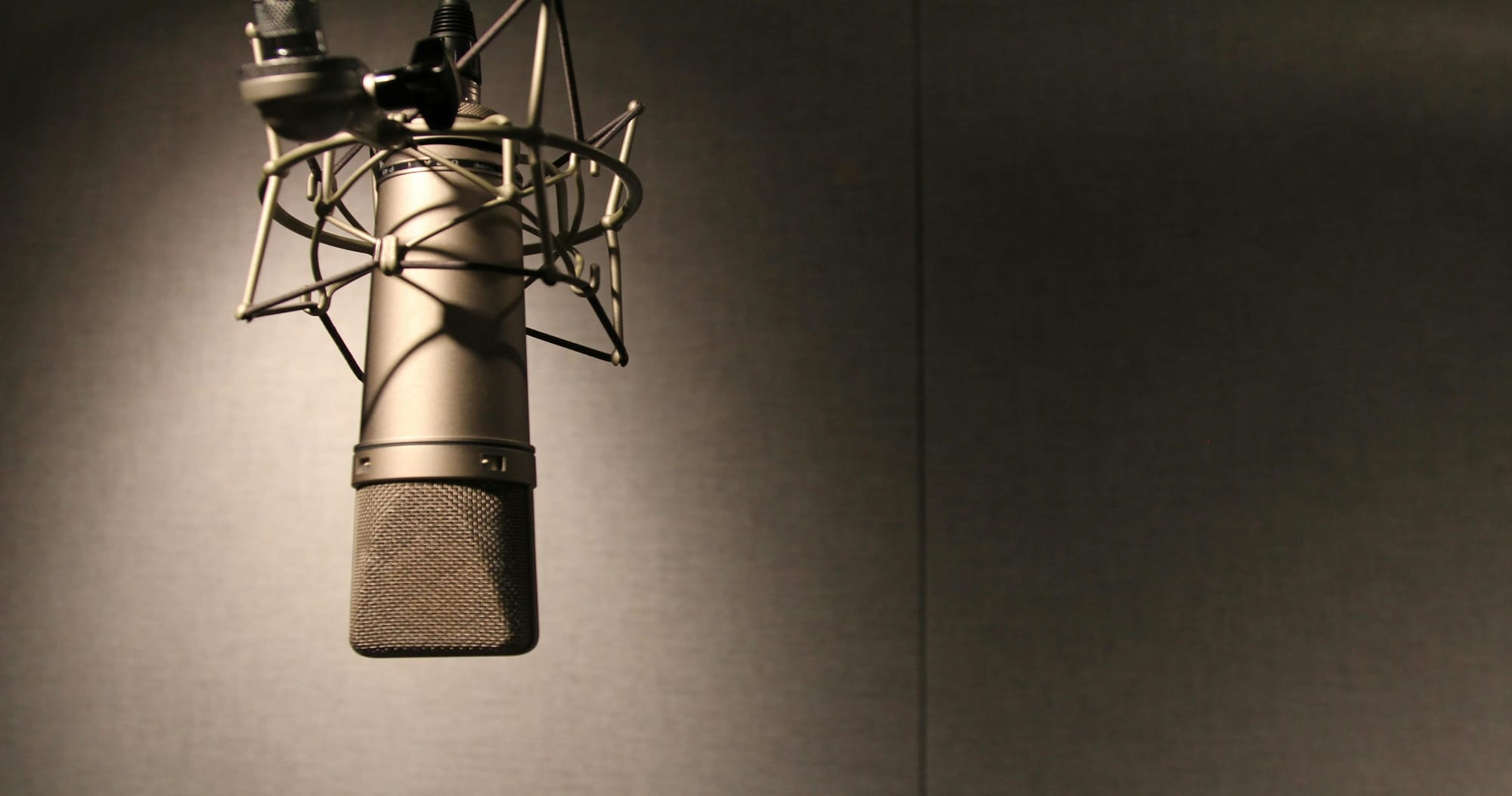
Voice-over (VO) production has always been one of the most resource-intensive stages in video creation. For dubbing studios, video agencies, and production companies, voice recording often becomes a financial and logistical bottleneck. From repeated recording sessions to localization and last-minute changes, VO can eat into both budgets and deadlines.
Has voice-over really become so expensive? Market forces, multiple revisions, and localization costs
Voice-over production has earned its reputation as a costly stage in video creation, but is it truly justified? Insights from industry leaders like Voices.com reveal that VO pricing hinges on usage - broadcast or non-broadcast - script length, talent experience, and project reach. For example, non-broadcast projects average between $325 for short (0–2 min) scripts and up to $1,500 for hour-long pieces; broadcast work (e.g. TV spots) ranges from $650 for 13 weeks locally to over $2,175 for year-long national usage.
Meanwhile, Voquent underscores that low-cost VO may backfire - cheap talent often lacks the training, inflection, and nuance that differentiate good narrators from great ones. A subtle misstep in tone or timing can leave the final product feeling flat and disengaging.
To understand where all the expenses enumerated above, come from, let’s look at typical cost ranges across different formats and providers:
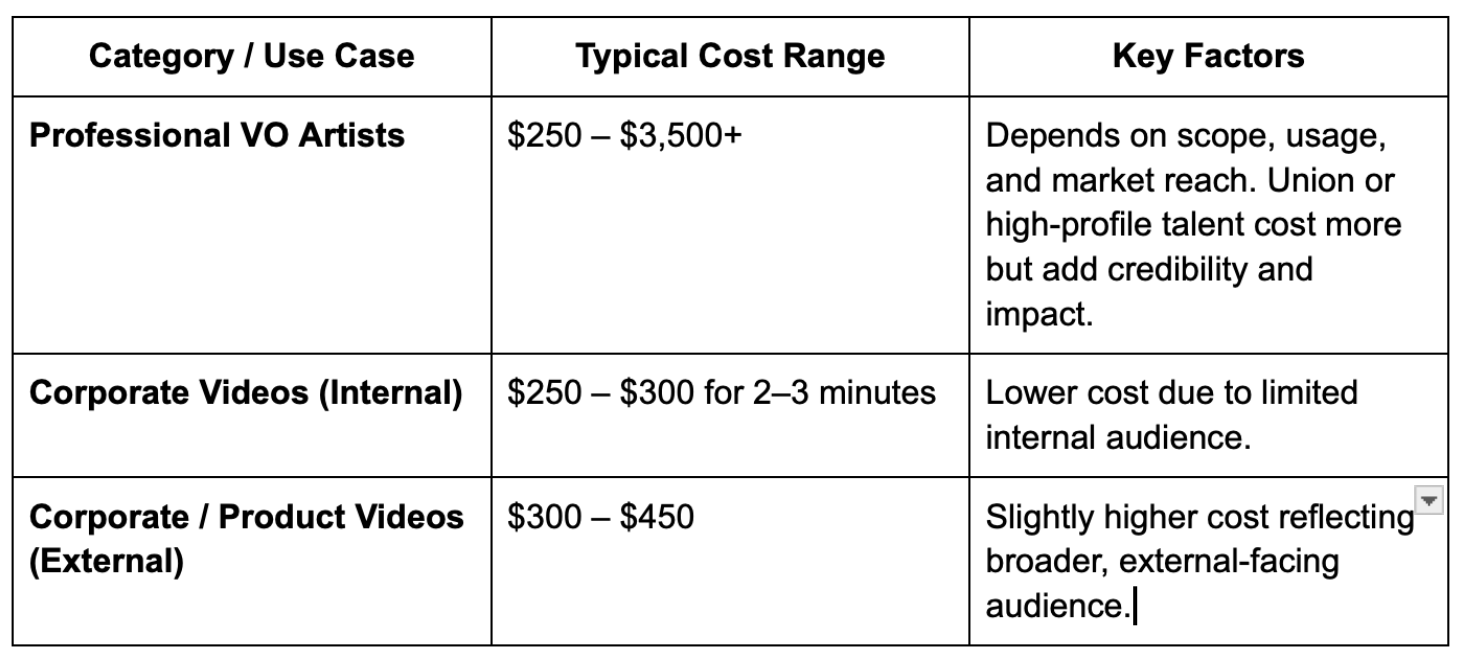
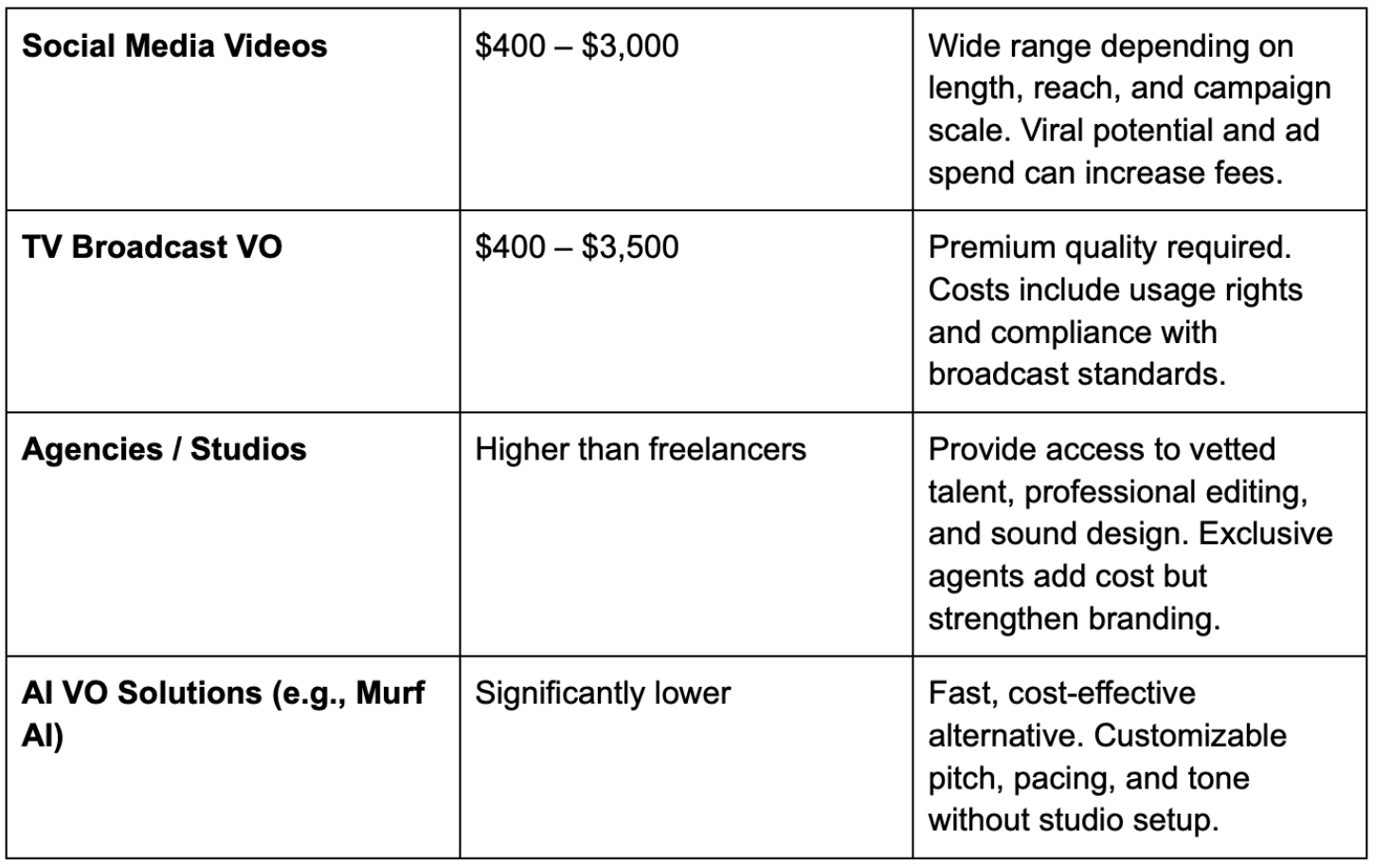
The numbers make it clear that professional VO is more than just a voice: it’s an investment in credibility, emotional impact, and technical quality. While rates may seem high, they reflect the skill, time, and rights involved.
And with AI solutions emerging, studios now face a choice: pay premium for human nuance or adopt cost-effective tools that streamline production without sacrificing flexibility.
Voice-over production pains: what really drives costs up
The cost of VO production has grown due to several overlapping factors:
- Talent fees: professional voice actors charge per project, language, and usage rights. A single 60-second commercial VO can range anywhere from $300 to $1,000+ depending on the market;
- Revisions & re-records: even small script edits- like updating a slogan - can mean rebooking a studio, paying the talent again, and remixing. The high cost of repeat sessions makes revisions a major pain point;
- Localization demands: global campaigns often need 5–10 language versions, multiplying costs and making quick voice or language replacement in finished material difficult;
- Technical limitations: once VO is mixed with music or background sounds, separating elements cleanly is nearly impossible without stems. This creates added challenges when trying to update, reuse, or localize existing content;
- Audio cleanup challenges: removing music, noise, or background sounds from finished tracks is complex and time-consuming, often requiring expensive post-production.
Where budgets get drained in voice-over workflows
Common scenarios driving VO overspending include:
- Frequent re-recordings caused by script changes, compliance updates, or inconsistent voice quality, requiring repeated studio bookings and editing. For large-scale script changes exceeding 20% or 30% of the original script, clients are charged for re-recording time, studio rental, and production costs, often at the original hourly or project rate;
- Booking high-profile or union actors without fully negotiating usage rights, buyouts, or pickup terms, which can inflate costs significantly;
- Multi-language rollouts, where each version requires separate talent, studio time, and mixing sessions. A real case: a multinational producing training videos in 120+ languages faced soaring costs from casting, repeated sessions, script adaptations, and editing. Poor script management and weak coordination caused delays that further inflated expenses;
- Archival projects, where updates are needed but original stems are missing, making revisions expensive and time-consuming. Other related costs could be archival storage and data management adding extra long-term costs that are not directly related to VO itself but impacting budgeting for archival projects. This includes tape media replacement every 3-5 years and equipment costs, for example;
- Advertising campaigns with frequent A/B testing, leading to multiple takes and escalating budgets. When A/B testing involves recording multiple variants of the same ad (e.g., different calls to action or tone), costs multiply by the number of versions. For example, testing 5 variants of a 60-second ad could cost between $1,500 and $15,000 or more in VO production alone;
- Rigid studio workflows that duplicate costs on small projects, particularly when simpler solutions or freelancers could suffice. One voice actor noted that fixing every small audio flaw on the spot, instead of batching edits, added 40 minutes to a long narration - an inefficiency that multiplied into higher time and cost across the project.
These scenarios show how easily VO budgets spiral out of control often doubling or tripling initial estimates. From re-recordings and multi-language rollouts to inefficient workflows, small oversights compound into major expenses. Without careful planning, negotiation, and streamlined processes, VO production becomes one of the most unpredictable and costly parts of content creation.
The voice-over game-changers: stem separation & voice cloning
This is where AI-based technologies like LALAL.AI step in to address the common overspending challenges in VO workflows.
With what tasks LALAL.AI can help?
- Stem separation: LALAL.AI’s Stem Splitter can extract vocals and instruments into separate stems. As it’s stated in the interview with VML representative, “LALAL.AI helps you remove vocal and instrumental tracks without losing quality”. This means even when original raw files are missing, studios can isolate dialogue, replace or edit lines, and keep the rest of the mix intact avoiding costly re-recordings.
- Voice cloning: once separated, voices can be cloned with the help of LALAL.AI’s Voice Cloner, giving studios the ability to generate new VO lines in the same style and tone without recalling talent. As highlighted in the interview with VoiceCheap CEO, “voice cloning technology allows content creators to preserve the original voice identity while generating speech in different languages”. This tackles the pain of multi-language rollouts and last-minute compliance edits that typically double project budgets;
- Workflow efficiency: by combining stem separation and cloning, editors can modernize e-learning and corporate videos, localize training in dozens of languages, and quickly fix errors without costly sessions. According to Ollang case study, “AI-driven tools reduce manual editing and re-recording, allowing creators to focus on storytelling rather than technical constraints”.
Together, these capabilities directly address the very scenarios where VO budgets spiral out of control, such as frequent re-recordings, multi-language duplication, archival updates, and inefficient workflows, turning them into faster, cheaper, and more flexible processes.
Real-world use cases
Studios already apply AI-based stem separation and cloning to cut costs and time, here are some examples:
- Replacing VO without reshoots
- Example: a corporate client updates a product name. Instead of re-recording, the studio separates and replaces only the affected line;
- Localization at scale
- Case study: Ollang integrates LALAL.AI to streamline dubbing workflows, cutting hours of manual re-recording;
- Quick translation of ad spots
- Advertising agencies use cloned voices for multilingual rollouts, ensuring brand consistency while saving thousands in VO talent fees;
- E-learning course updates
- Example: Video editors using LALAL.AI clean old voice tracks to refresh training content without re-recording full courses.
Practical savings
Audio engineers and producers report time savings from hours to minutes when isolating vocals or dialogue in complex mixes using AI stem separation tools like LALAL.AI. Less manual effort means less labor cost and faster turnaround
Traditional voice-over production with professional voice artists can cost hundreds to thousands of dollars per project, especially when multiple takes, editing, and revisions are involved. Different resources can indicate different percentages by which AI voice-over solutions can reduce these costs, producing studio-quality audio quickly without the need for expensive studio time or talent fees, according to some of them, it can go up to 80%.
Where to start
Studios can integrate LALAL.AI at several points in their pipeline:
- Post-production edits – separate and replace lines without touching the visuals;
- Localization workflows – use voice cloning to deliver multiple languages faster;
- Archival projects – clean and update legacy voice-over tracks for modern use.
By adopting stem separation and voice cloning, video agencies and dubbing studios can future-proof their workflows while keeping costs under control.
How does LALAL.AI work?
- LALAL.AI is available online, so just go to LALAL.AI website and choose the product needed from Products’ section (or use a desktop/Android/iOS app).
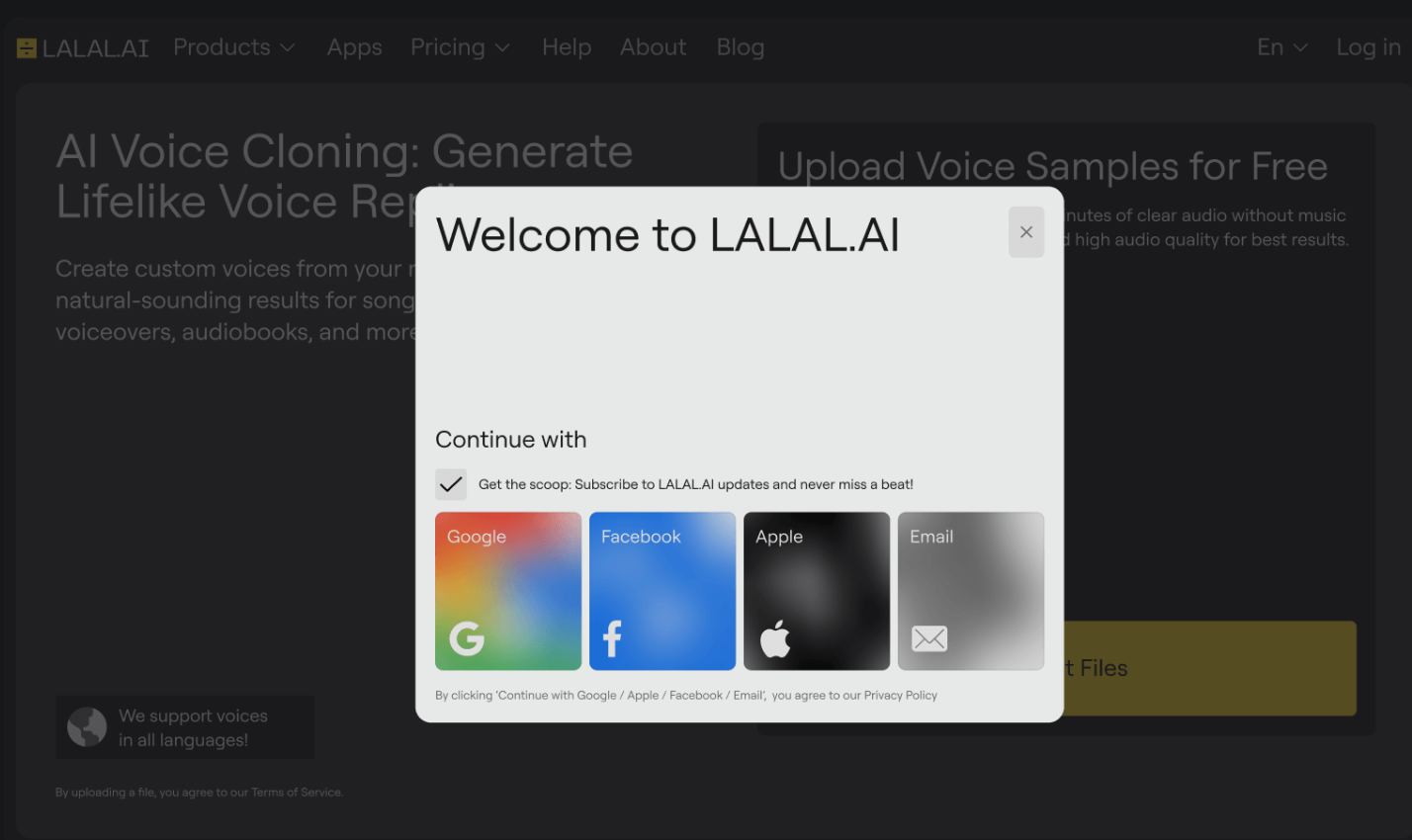
- Log in using one of several login options available.
- Then, click on Select Files/Choose Audio or Video/Choose song depending on the product you will be using and just follow the process! Then just wait until the audio is processed, that’s all.
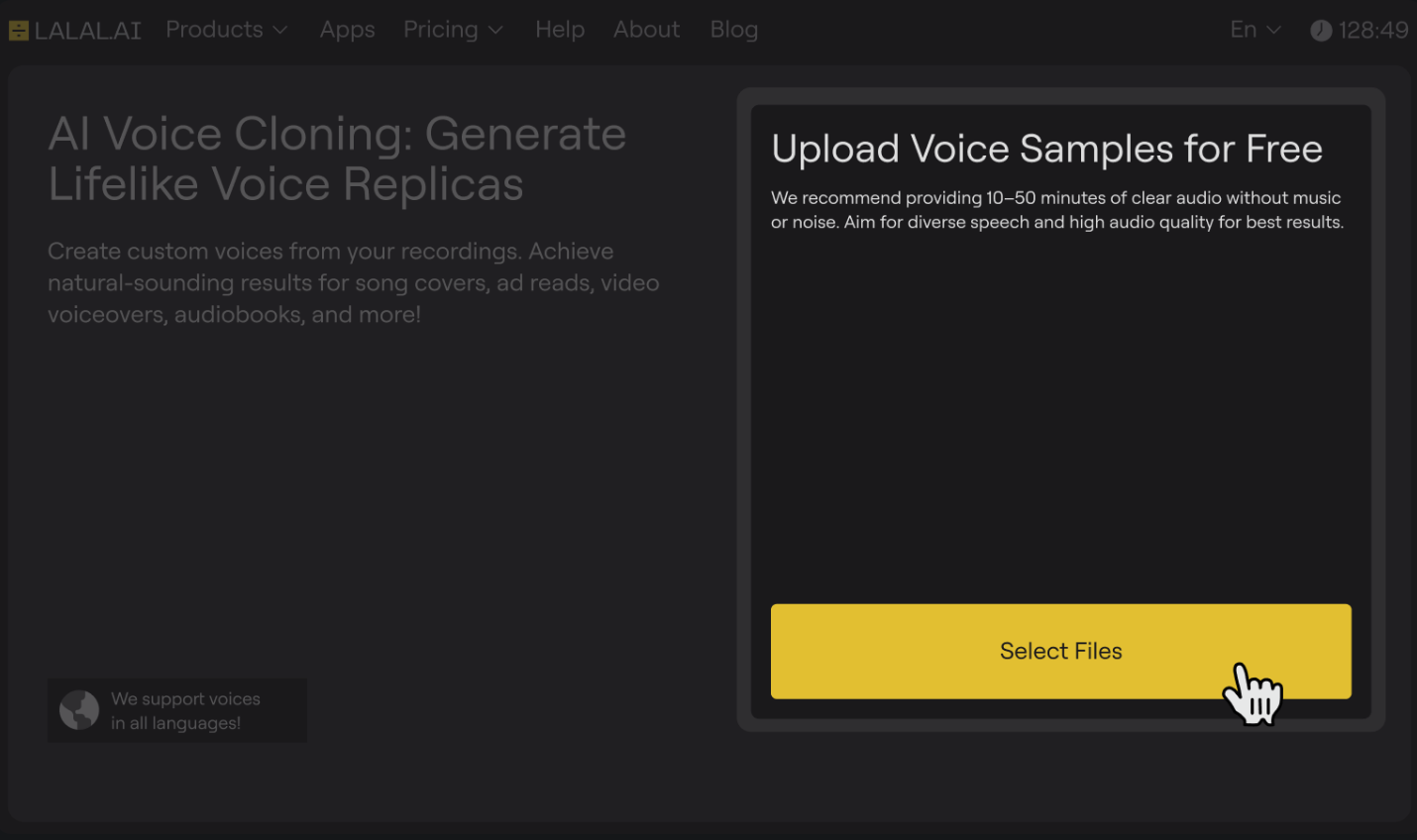
Voice-over production remains one of the most expensive and unpredictable stages in video creation, with costs driven by talent fees, re-recordings, localization, and inefficient workflows. As real-world cases demonstrate, budgets can easily double or triple when projects involve frequent updates, multi-language rollouts, or rigid studio practices.
AI-driven tools like LALAL.AI are redefining this landscape. By combining stem separation and voice cloning, studios can update scripts, localize content, and repurpose archival material without costly re-recordings or repeated talent sessions. Case studies from clients like Ollang show that these tools not only reduce production expenses by up to 80% but also streamline workflows, making it possible to deliver high-quality content faster and at scale.
For agencies, dubbing studios, and video producers, the takeaway is clear: adopting AI-powered solutions is no longer just a competitive advantage - it’s rapidly becoming a necessity to stay efficient, flexible, and cost-effective in today’s global media market. Start with the free Starter Pack, scale up with extended plans for larger catalogs, or explore tailored business solutions designed to streamline your sync and voice-over workflows.
Follow LALAL.AI on Instagram, Facebook, Twitter, TikTok, Reddit, LinkedIn, and YouTube to keep up with all our updates and special offers.
